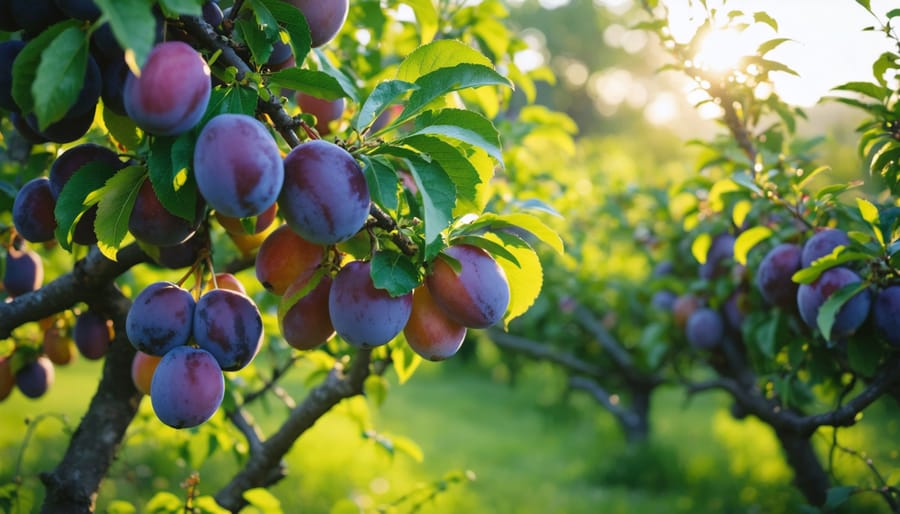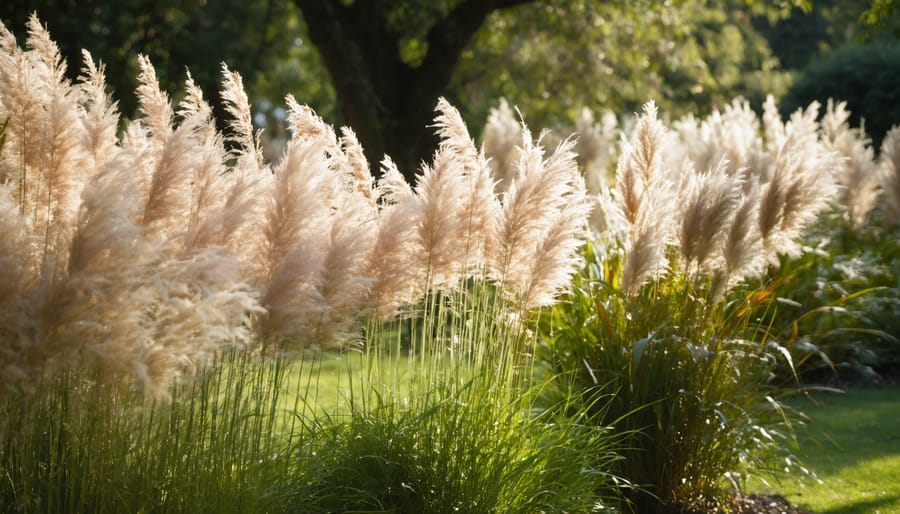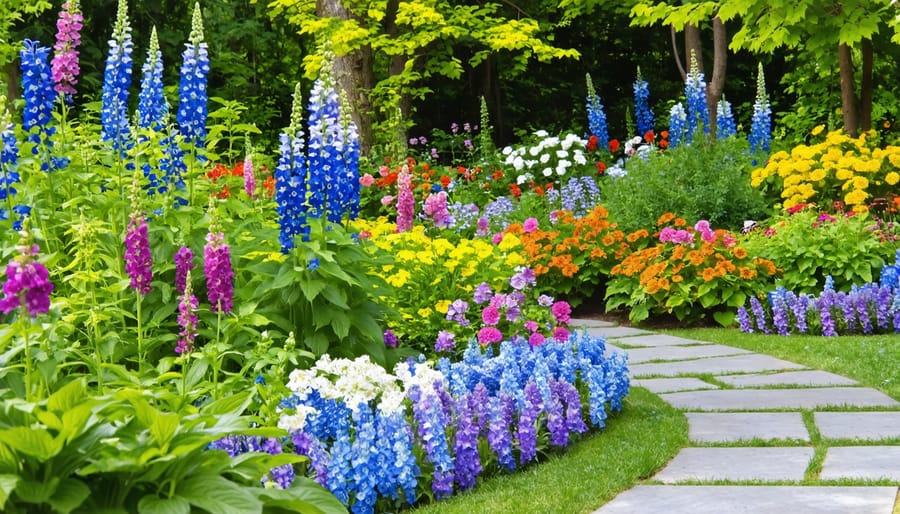Transform your kitchen windowsill or backyard into a thriving herb garden in just a few simple steps. Starting an herb garden delivers fresh flavors at your fingertips while saving money on store-bought herbs. Choose 3-4 beginner-friendly herbs like basil, mint, rosemary, or thyme to build confidence as you develop your green thumb. Select a location that receives 4-6 hours of direct sunlight daily, and fill containers with well-draining potting soil mixed with organic compost. Keep your herbs within easy reach of your kitchen, and you’ll find yourself naturally incorporating fresh, aromatic ingredients into your daily cooking.
Small spaces work perfectly for herb gardens – even a sunny windowsill can produce enough herbs to elevate your cooking year-round. The satisfaction of snipping fresh herbs for your meals, combined with their delightful fragrances and minimal maintenance requirements, makes herb gardening an ideal entry point into the rewarding world of growing your own food. Whether you’re an apartment dweller or have a spacious backyard, creating your first herb garden is a simple yet transformative step toward a more sustainable and flavorful lifestyle.
Choosing the Perfect Location for Your Herb Garden
Indoor vs. Outdoor Considerations
When starting your herb garden, you’ll need to decide between indoor and outdoor growing – and the good news is, both options can yield fantastic results! Indoor herb gardens are perfect for year-round growing and offer complete control over growing conditions. They’re ideal if you have limited outdoor space or live in an area with harsh winters. Plus, having fresh herbs right in your kitchen means easy access while cooking.
Outdoor herb gardens, however, give plants more room to flourish and typically produce larger yields. Many herbs thrive in natural sunlight and benefit from rain and natural pollinators. The outdoor environment can also enhance the flavor and aroma of your herbs.
Consider these factors when choosing:
Indoor Pros:
– Year-round growing
– Protection from pests and weather
– Convenient kitchen access
– Easy climate control
Indoor Cons:
– Limited growing space
– May need grow lights
– Higher humidity management needed
Outdoor Pros:
– More growing space
– Natural sunlight
– Better air circulation
– Lower maintenance
Outdoor Cons:
– Seasonal limitations
– Weather vulnerability
– Pest management needed
– Less control over growing conditions
Remember, you can always start indoors and expand outdoors as your confidence grows!
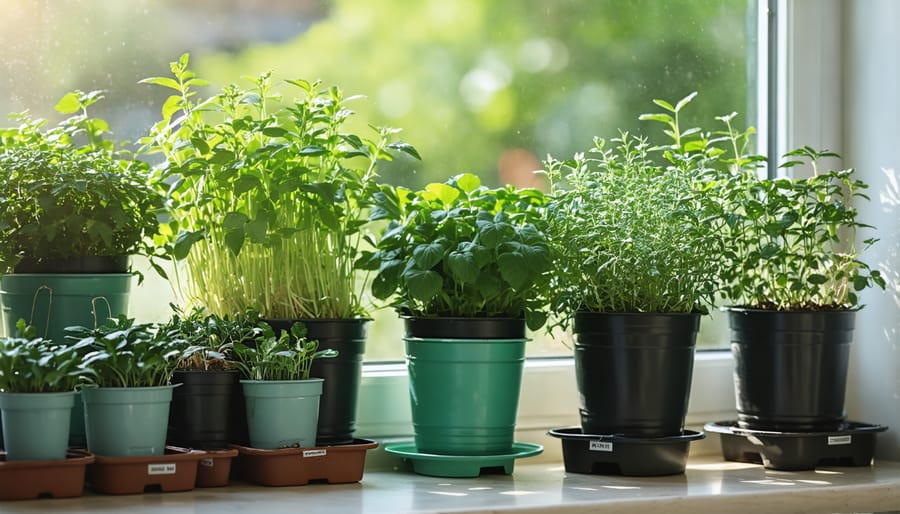
Light Requirements
Light is crucial for growing healthy herbs, and different varieties have specific sunlight requirements. Most herbs thrive in full sun, needing at least 6 hours of direct sunlight daily. Mediterranean herbs like basil, rosemary, sage, and thyme are particularly sun-loving and will produce the most flavorful leaves when given plenty of light.
However, some herbs can tolerate partial shade. Mint, parsley, cilantro, and chives can grow successfully with 4-6 hours of sunlight. If you’re growing herbs indoors or have a partially shaded garden, these varieties are your best bet for success.
When planning your herb garden, observe your space throughout the day to identify the sunniest spots. Remember that summer sun patterns differ from winter, so consider seasonal changes. If you’re growing herbs indoors, place them near a south-facing window for maximum light exposure. For herbs that need less intense light, east or west-facing windows work well.
Don’t worry if your garden isn’t perfectly sunny – you can always adapt your herb choices to match your available light conditions.
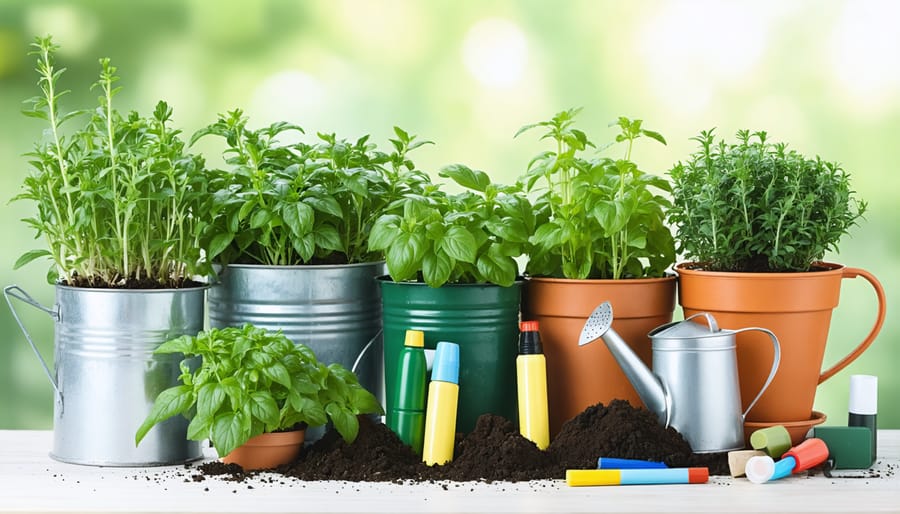
Essential Tools and Materials
Container Selection
Choosing the right container is crucial for successful container herb gardening. The good news is that herbs aren’t too picky – they’ll grow in almost anything that holds soil and has proper drainage. Terra cotta pots are excellent choices as they’re porous and allow roots to breathe, while plastic containers are lightweight and retain moisture well. For beginners, I recommend starting with containers at least 6 inches deep and wide.
Whatever container you choose, drainage is non-negotiable. Your pots must have holes in the bottom to prevent water from pooling around the roots, which can lead to root rot. If you’re upcycling containers like wooden boxes or decorative pots, drill several quarter-inch drainage holes in the bottom. Place a layer of gravel or broken pottery pieces at the bottom to improve drainage further.
Consider grouping herbs with similar water needs in the same container. Just ensure the pot is large enough to accommodate full-grown plants – about 4 inches of space per herb is a good rule of thumb. Remember to place a saucer underneath to catch excess water and protect your surfaces.
Soil and Amendments
The foundation of a thriving herb garden lies in its soil. For container gardens, start with a high-quality potting mix specifically formulated for herbs and vegetables. This specialized mix provides better drainage and aeration than regular garden soil, which can become compacted in containers. For best results, look for organic mixes containing perlite, vermiculite, and aged compost.
Most herbs prefer well-draining soil with a neutral to slightly acidic pH (between 6.0 and 7.0). To enhance your soil’s fertility, incorporate organic matter like composted kitchen scraps or aged manure. These natural amendments not only improve soil structure but also provide essential nutrients your herbs need to flourish. For more detailed soil management tips, consider testing your soil’s pH and adjusting accordingly.
When preparing your containers or garden bed, mix in a slow-release organic fertilizer to provide steady nutrition throughout the growing season. However, be careful not to over-fertilize – herbs actually develop more intense flavors when grown in moderately fertile soil rather than rich, heavily amended earth.
Beginner-Friendly Herbs to Start With
Low-Maintenance Champions
When you’re just starting your herb garden journey, it’s wise to begin with some tried-and-true favorites that are known for their forgiving nature. Basil is a fantastic starter herb that thrives in sunny spots and rewards you with aromatic leaves perfect for cooking. Simply pinch off the top leaves regularly to encourage bushier growth, and you’ll have a constant supply for your favorite Italian dishes.
Mint is another champion of the low-maintenance herb world, though it comes with one caveat: plant it in containers to prevent it from spreading too enthusiastically throughout your garden. This vigorous grower adapts well to various conditions and bounces back even after occasional neglect. Both spearmint and peppermint are excellent choices for beginners.
Parsley might be the most reliable herb in your garden. Whether you choose flat-leaf or curly varieties, this biennial herb grows steadily and provides fresh leaves throughout the growing season. It’s quite tolerant of different light conditions and continues producing even when temperatures drop.
These three herbs share some beginner-friendly characteristics: they’re relatively pest-resistant, adapt well to container growing, and give clear signals when they need water (their leaves will start to droop). They also produce abundantly, meaning even if you make a few mistakes along the way, you’ll still have plenty of herbs to harvest and enjoy in your cooking.
Companion Planting Basics
Companion planting is a delightful way to make your herb garden more productive and harmonious. Many herbs naturally complement each other, not just in the kitchen but also in the garden. For instance, basil grows wonderfully alongside oregano and parsley, as they share similar water and sunlight needs.
Tall herbs like dill and fennel make excellent neighbors for shorter varieties like thyme and oregano, creating a natural layered effect that maximizes space. However, keep mint in separate containers, as it tends to spread aggressively and can overwhelm other herbs.
Some particularly successful herb combinations include:
– Sage and rosemary (both love sunny, dry conditions)
– Parsley and basil (enjoy similar moisture levels)
– Thyme and oregano (both thrive in well-drained soil)
– Cilantro and dill (work well in partial shade)
When planning your herb garden, remember that Mediterranean herbs like lavender, rosemary, and thyme prefer drier conditions and can be grouped together. Meanwhile, moisture-loving herbs such as parsley, chives, and basil make great companions in another section of your garden.
For the best results, observe how your herbs interact over time. Some plants might perform better than others in certain combinations, helping you create your own perfect herb garden ecosystem.
Planting and Care Instructions
Planting Methods
When starting your herb garden, you’ll need to choose between growing from seeds or using transplants (young plants). Both methods have their advantages, and your choice will depend on your patience level and gardening goals.
Starting from seeds is more economical and gives you access to a wider variety of herbs. To begin, fill your containers with seed-starting mix, leaving about an inch of space at the top. Make small indentations according to the seed packet instructions – most herb seeds only need to be planted about ¼ inch deep. Sprinkle 2-3 seeds per hole, as not all seeds will germinate. Keep the soil consistently moist but not waterlogged, and place your containers in a warm spot with plenty of indirect sunlight.
Transplants offer instant gratification and are perfect for beginners who want to start harvesting herbs sooner. When planting transplants, dig a hole slightly larger than the root ball. Gently remove the plant from its container, loosen the roots if they’re tightly bound, and place it in the hole at the same depth it was growing before. Fill in with soil and water thoroughly.
For the best results, plant small-leaved herbs like thyme and oregano from transplants, as they can be tricky to start from seed. Larger herbs like basil and cilantro grow easily from either method. Remember to space your plants according to their mature size to prevent overcrowding.
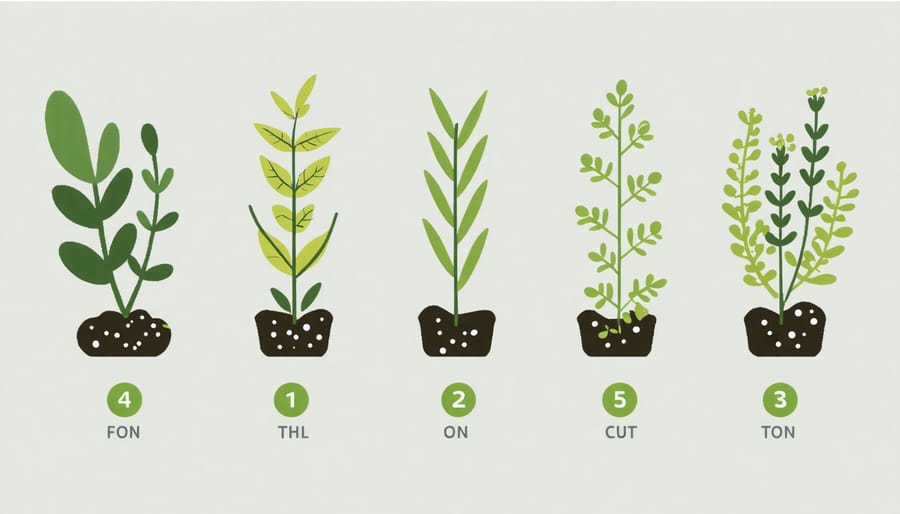
Watering Guidelines
Proper watering is crucial for a thriving herb garden, but it doesn’t have to be complicated. Most herbs prefer consistently moist soil but don’t like to be waterlogged. The best way to check if your herbs need water is to stick your finger about an inch into the soil – if it feels dry at that depth, it’s time to water.
Water your herbs early in the morning to reduce evaporation and prevent fungal growth. Direct the water at the base of the plants rather than spraying the leaves, which can lead to leaf burn or disease. For container herbs, water until you see it flowing from the drainage holes, then allow the excess to drain completely.
Different herbs have varying water needs. Mediterranean herbs like rosemary, thyme, and sage prefer drier conditions and should be watered less frequently. Meanwhile, basil, mint, and parsley enjoy more moisture and may need watering every few days, especially during hot weather.
Remember that herbs growing in containers typically need more frequent watering than those planted in the ground. During rainy periods, adjust your watering schedule accordingly to prevent overwatering.
Maintenance Tips
Regular maintenance keeps your herb garden thriving and productive. For pruning, pinch off the top sets of leaves regularly to encourage bushier growth and prevent your herbs from becoming leggy. When harvesting, cut stems close to a leaf intersection, taking no more than one-third of the plant at a time. This ensures your herbs will continue growing strong.
Most herbs benefit from harvesting – the more you pick, the more they grow! Morning is the best time to harvest, after the dew has dried but before the day gets too hot. This is when the essential oils are most concentrated in the leaves.
For pest control, start with prevention by maintaining good air circulation between plants and removing any dead or diseased foliage promptly. Many common garden pests dislike the strong scents of herbs, but watch out for aphids and spider mites. A strong spray of water often dislodges these pests, or you can use insecticidal soap as a natural solution. Remember to check the undersides of leaves regularly for early signs of trouble.
Keep your herbs healthy by removing any flowers unless you’re specifically growing them for seed. This helps direct the plant’s energy into producing more flavorful leaves.
Common Mistakes to Avoid
Even experienced gardeners make mistakes, but learning from common pitfalls can help you create a thriving herb garden from the start. One frequent error is overcrowding plants – remember that herbs need room to grow and spread. Give each plant adequate space according to its mature size, typically 12-18 inches apart for most varieties.
Another mistake is incorrect watering practices. While it’s tempting to water a little bit every day, this encourages shallow root systems. Instead, water deeply but less frequently, allowing the soil to dry slightly between waterings. However, don’t let the soil dry out completely, as this can stress your herbs.
Many beginners plant herbs with conflicting needs together. For instance, placing moisture-loving basil next to drought-tolerant rosemary can lead to problems. Group herbs with similar water and sunlight requirements for better success.
Poor drainage is another common issue. Herbs hate sitting in waterlogged soil, which can lead to root rot. Always ensure your containers have drainage holes and use well-draining potting mix.
Lastly, many new gardeners forget to harvest regularly. Regular pruning actually encourages bushier growth and prevents herbs from becoming woody or going to seed too quickly. Don’t be shy about using your herbs – most varieties benefit from frequent trimming, and it’s the best way to enjoy the fruits of your labor!
Starting your own herb garden is a rewarding journey that brings fresh flavors and aromas right to your doorstep. As we’ve explored, you don’t need extensive gardening experience or a huge space to grow your own herbs successfully. With the right containers, quality soil, adequate sunlight, and proper watering techniques, you’ll be well on your way to cultivating a thriving herb garden. Remember to start small with just a few herbs you frequently use, and gradually expand your collection as you gain confidence. The satisfaction of snipping fresh herbs for your cooking and the joy of watching your plants grow make this hobby truly fulfilling. Don’t be discouraged by early setbacks – every gardener learns through experience. Now that you have all the essential knowledge, it’s time to roll up your sleeves and start planting your very own herb garden. Happy gardening!


